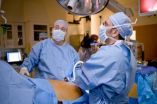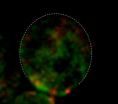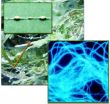(Press-News.org) PHILADELPHIA - Independent clinical trials, including one conducted at the Scheie Eye Institute at the Perelman School of Medicine, have reported safety and efficacy for Leber congenital amaurosis (LCA), a congenital form of blindness caused by mutations in a gene (RPE65) required for recycling vitamin A in the retina. Inherited retinal degenerative diseases were previously considered untreatable and incurable. There were early improvements in vision observed in the trials, but a key question about the long-term efficacy of gene therapy for curing the retinal degeneration in LCA has remained unanswered. Now, new research from the Scheie Eye Institute, published this week in the Proceedings of the National Academy of Sciences, finds that gene therapy for LCA shows enduring improvement in vision but also advancing degeneration of affected retinal cells, both in LCA patients and animal models of the same condition.
LCA disease from RPE65 mutations has two-components: a biochemical blockade leading to impaired vision, and a progressive loss of the light-sensing photoreceptor cells throughout life of the affected patient. The authors of the new study explain that until now gene therapy has been optimistically assumed, but not proven, to solve both disease components at the same time.
"We all hoped that the gene injections cured both components – re-establishing the cycle of vision and also preventing further loss of cells to the second disease component" said Artur V. Cideciyan, PhD, lead author and co-investigator of an LCA clinical trial at Penn.
Yet, when the otherwise invisible cell layers of the retina were measured by optical imaging in clinical trial participants serially over many years, the rate of cell loss was the same in treated and untreated regions. "In other words, gene therapy improved vision but did not slow or halt the progression of cell loss," commented
Cideciyan.
"These unexpected observations should help to advance the current treatment by making it better and longer lasting," commented co-author Samuel G. Jacobson, MD, PhD, principal investigator of the clinical trial. "Slowing cell loss in different retinal degenerations has been a major research direction long before the current gene therapy trials. Now, the two directions must converge to ensure the longevity of the beneficial visual effects in this form of LCA."
In a continuation of the longstanding collaboration between the Scheie investigators and the Section of Ophthalmology at Penn School of Veterinary Medicine headed by co-authors Gustavo D. Aguirre, VMD, PhD, and William A. Beltran, DVM, PhD, studies were performed to test whether the clinical results were also present in the canine model of this LCA at disease stages equivalent to those in human patients. "Our gene treatment in this canine model provided the groundwork for the clinical trials of patients, and now we added data to confirm the fact that retinal degeneration does continue despite improved vision" said Aguirre. "The next step is to perform the relevant experiments to ask what intervention will stop the degeneration if added to the gene therapy."
"These new findings contribute to greater clarity in understanding the natural history and complexity of the RPE65 form of LCA and provide a firm foundation for future investigations," said Joan M. O'Brien MD, professor and chair of the Department of Ophthalmology and director of the Scheie Eye Institute.
###Co-authors, in addition to the Penn researchers include, William W. Hauswirth, PhD, professor of Ophthalmology, at the University of Florida, Gainesville.
The current patient studies and the experimental studies were supported by the National Eye Institute (NEI) grants U10 EY017280, EY 06855, 017549, 019304, and 022012, the Macula Vision Research Foundation, and the Foundation Fighting Blindness.
Penn Medicine is one of the world's leading academic medical centers, dedicated to the related missions of medical education, biomedical research, and excellence in patient care. Penn Medicine consists of the Raymond and Ruth Perelman School of Medicine at the University of Pennsylvania (founded in 1765 as the nation's first medical school) and the University of Pennsylvania Health System, which together form a $4.3 billion enterprise.
The Perelman School of Medicine is currently ranked #2 in U.S. News & World Report's survey of research-oriented medical schools. The School is consistently among the nation's top recipients of funding from the National Institutes of Health, with $479.3 million awarded in the 2011 fiscal year.
The University of Pennsylvania Health System's patient care facilities include: The Hospital of the University of Pennsylvania -- recognized as one of the nation's top "Honor Roll" hospitals by U.S. News & World Report; Penn Presbyterian Medical Center; and Pennsylvania Hospital — the nation's first hospital, founded in 1751. Penn Medicine also includes additional patient care facilities and services throughout the Philadelphia region.
Penn Medicine is committed to improving lives and health through a variety of community-based programs and activities. In fiscal year 2011, Penn Medicine provided $854 million to benefit our community.
Penn study sheds light on the complexity of gene therapy for congenital blindness
New discoveries provide a path to a more complete cure with gene therapy treatment
2013-01-22
ELSE PRESS RELEASES FROM THIS DATE:
Study: Bariatric surgery in extremely obese adolescents
2013-01-22
This time of year many people make resolutions to live a healthier lifestyle, exercise more, lose weight and eat better. For the adolescents who are extremely obese in this country, diet and exercise alone often are not enough to get their weight down. Some of those teens will require weight loss surgery to improve their overall health. According to a recent study published in the January print issue of the Journal of Pediatric Surgery, bariatric surgery in extremely obese adolescents also was shown to be beneficial in helping to reverse previously undiagnosed cardiovascular ...
UBC research: Forget about fair – It's better when bosses pick favorites
2013-01-22
A new study from the University of British Columbia Sauder School of Business shows that bosses should pick favourites if they want top performing teams.
"Conventional wisdom tells us that we should treat everyone the same to create a collegial and productive work atmosphere," says Sauder Professor Karl Aquino, who co-authored the forthcoming study for the Journal of Business Ethics. "But our research shows this can be a disincentive for workers who would otherwise go above and beyond on behalf of the team with a little bit of extra attention."
In a series of experiments, ...
A relative from the Tianyuan Cave
2013-01-22
This press release is available in German.
An international team of researchers including Svante Pääbo and Qiaomei Fu of the Max Planck Institute for Evolutionary Anthropology in Leipzig, Germany, sequenced nuclear and mitochondrial DNA that had been extracted from the leg of an early modern human from Tianyuan Cave near Beijing, China. Analyses of this individual's DNA showed that the Tianyuan human shared a common origin with the ancestors of many present-day Asians and Native Americans. In addition, the researchers found that the proportion of Neanderthal and Denisovan-DNA ...
Enzyme replacement therapy shows promising results in X-linked myotubular myopathy
2013-01-22
A collaborative research team including a Medical College of Wisconsin (MCW) pediatric neuropathologist successfully mitigated some of the effects of a muscular disease by using a new targeted enzyme replacement therapy strategy from 4s3 Bioscience.
The findings are published in the January edition of Human and Molecular Genetics http://hmg.oxfordjournals.org/content/early/2013/01/09/hmg.ddt003.full.pdf+html.
X-linked myotubular myopathy (XLMTM) is a severe muscle disease caused by an absence of a protein called myotubularin. There is currently no treatment for this ...
New 2D material for next generation high-speed electronics
2013-01-22
Scientists at CSIRO and RMIT University have produced a new two-dimensional material that could revolutionise the electronics market, making "nano" more than just a marketing term.
The material – made up of layers of crystal known as molybdenum oxides – has unique properties that encourage the free flow of electrons at ultra-high speeds.
In a paper published in the January issue of materials science journal Advanced Materials, the researchers explain how they adapted a revolutionary material known as graphene to create a new conductive nano-material.
Graphene was ...
Study of how eye cells become damaged could help prevent blindness
2013-01-22
Light-sensing cells in the eye rely on their outer segment to convert light into neural signals that allow us to see. But because of its unique cylindrical shape, the outer segment is prone to breakage, which can cause blindness in humans. A study published by Cell Press on January 22nd in the Biophysical Journal provides new insight into the mechanical properties that cause the outer segment to snap under pressure. The new experimental and theoretical findings help to explain the origin of severe eye diseases and could lead to new ways of preventing blindness.
...
Controlling spine metastases with tumor 'separation surgery' and high-dose stereotactic radiosurgery
2013-01-22
Charlottesville, VA (January 22, 2013). Researchers from Memorial Sloan-Kettering Cancer Center (New York, NY) have found that tumor "separation surgery" followed by high-dose hypofractionated stereotactic radiosurgery (SRS) or high-dose single-fraction SRS is safe and effective in controlling spinal metastases regardless of the radiosensitivity of the particular tumor type that has invaded the spine. This finding is fleshed out in the article "Local disease control for spinal metastases following 'separation surgery' and adjuvant hypofractionated or high-dose single-fraction ...
Evidence mounts for role of mutated genes in development of schizophrenia
2013-01-22
Johns Hopkins researchers have identified a rare gene mutation in a single family with a high rate of schizophrenia, adding to evidence that abnormal genes play a role in the development of the disease.
The researchers, in a report published in the journal Molecular Psychiatry, say that family members with the mutation in the gene Neuronal PAS domain protein 3 (NPAS3) appear at high risk of developing schizophrenia or another debilitating mental illnesses.
Normally functioning NPAS3 regulates the development of healthy neurons, especially in a region of the brain known ...
A diffusion trap
2013-01-22
KANSAS CITY, MO – Over the past several years, Rong Li, Ph.D., at the Stowers Institute for Medical Research has been making crucial discoveries about the development of cell polarity—the process by which one side of a cell becomes different from the other side. Such polarity is critical for the functioning of the vast majority of cells. The outside surface of skin cells is very different from the surface inside the body, for example, while nerve cells have delicately branching dendrites on one end and axons on the other. Li's lab studies yeast cells, which form a unique ...
Synchrotron infrared unveils a mysterious microbial community
2013-01-22
In the fall of 2010, Hoi-Ying Holman of the U.S. Department of Energy's Lawrence Berkeley National Laboratory (Berkeley Lab) was approached by an international team researching a mysterious microbial community discovered deep in cold sulfur springs in southern Germany.
"They told me what they were doing and said, 'We know what you contributed to the oil-spill research,'" recalls Holman, who heads the Chemical Ecology group in Berkeley Lab's Earth Sciences Division. "They wondered if I could help them determine the biochemistry of their microbe samples."
Holman had ...
LAST 30 PRESS RELEASES:
Artificial saliva containing sugarcane protein helps protect the teeth of patients with head and neck cancer
Understanding the role of linear ubiquitination in T-tubule biogenesis
Researchers identify urban atmosphere as primary reservoir of microplastics
World’s oldest arrow poison – 60,000-year-old traces reveal early advanced hunting techniques
Bristol scientists discover early sponges were soft
New study uncovers how rice viruses manipulate plant defenses to protect insect vectors
NSF–DOE Vera C. Rubin Observatory spots record-breaking asteroid in pre-survey observations
Ribosomal engineering creates “super-probiotic” bacteria
This self-powered eye tracker harnesses energy from blinking and is as comfortable as everyday glasses
Adverse prenatal exposures linked to higher rates of mental health issues, brain changes in adolescents
Restoring mitochondria shows promise for treating chronic nerve pain
Nature study identifies a molecular switch that controls transitions between single-celled and multicellular forms
USU chemists' CRISPR discovery could lead to single diagnostic test for COVID, flu, RSV
Early hominins from Morocco reveal an African lineage near the root of Homo sapiens
Small chimps, big risks: What chimps show us about our own behavior
We finally know how the most common types of planets are created
Thirty-year risk of cardiovascular disease among healthy women according to clinical thresholds of lipoprotein(a)
Yoga for opioid withdrawal and autonomic regulation
Gene therapy ‘switch’ may offer non-addictive pain relief
Study shows your genes determine how fast your DNA mutates with age
Common brain parasite can infect your immune cells. Here's why that's probably OK
International experts connect infections and aging through cellular senescence
An AI–DFT integrated framework accelerates materials discovery and design
Twist to reshape, shift to transform: Bilayer structure enables multifunctional imaging
CUNY Graduate Center and its academic partners awarded more than $1M by Google.org to advance statewide AI education through the Empire AI consortium
Mount Sinai Health system receives $8.5 million NIH grant renewal to advance research on long-term outcomes in children with congenital heart disease
Researchers develop treatment for advanced prostate cancer that could eliminate severe side effects
Keck Medicine of USC names Christian Pass chief financial officer
Inflatable fabric robotic arm picks apples
MD Anderson and SOPHiA GENETICS announce strategic collaboration to accelerate AI-driven precision oncology
[Press-News.org] Penn study sheds light on the complexity of gene therapy for congenital blindnessNew discoveries provide a path to a more complete cure with gene therapy treatment



